Vacuum Packaging Can Protect Ground Beef Color and Oxidation during Cold Storage
Abstract
1. Introduction
2. Materials and Methods
2.1. Raw Materials
2.2. Packaging Treatments
2.3. Simulated Storage Periods
2.4. Lipid Oxidation
2.5. Instrumental Color
2.6. Proximate Analysis and pH Value
2.7. Statistical Analysis
3. Results and Discussion
3.1. Instrumental Color
3.2. Calculated Relative Pigments
3.3. Lipid Oxidation
4. Conclusions
Author Contributions
Funding
Institutional Review Board Statement
Informed Consent Statement
Data Availability Statement
Acknowledgments
Conflicts of Interest
References
- Jenkins, M. The Ground Beef Market and Price Signals; Angus Foundation. 2015. Available online: https://www.cabcattle.com/wp-content/uploads/MKT_GBNR_AF.pdf (accessed on 14 June 2024).
- An Overview of Ground Beef at Retail and Food Service. Available online: https://www.beefitswhatsfordinner.com/retail/sales-data-shopper-insights/ground-beef-at-retail-and-foodservice (accessed on 4 March 2024).
- Roerink, A.M. Meat Department Sales Shift to Value-Focused Channel. 2024. Available online: https://www.provisioneronline.com/articles/116275-meat-department-sales-shift-to-value-focused-channels (accessed on 25 June 2024).
- Eilert, S. New packaging technologies for the 21st century. Meat Sci. 2005, 71, 122–127. [Google Scholar] [CrossRef] [PubMed]
- Jenkins, W.A.; Harrington, J.P. Packaging of Foods with Plastics; Technomic Publishing Co.: Lancaster, PA, USA, 1991. [Google Scholar]
- Wang, Y.; Domínguez, R.; Lorenzo, J.M.; Bohrer, B.M. The Relationship between lipid content in Ground Beef Patties with Discoloration and Lipid Oxidation During Simulated Retail Display. Foods 2021, 10, 1982. [Google Scholar] [CrossRef] [PubMed]
- Renerre, M. Review: Factors involved in the discoloration of beef meat. Int. J. Food Sci. 1990, 25, 613–630. [Google Scholar] [CrossRef]
- Jeong, J.Y.; Claus, J.R. Color stability and reversion in carbon monoxide package ground beef. Meat Sci. 2010, 85, 525–530. [Google Scholar] [CrossRef]
- de Carvalho, F.A.L.; Lorenzo, J.M.; Pateiro, M.; Bermúdez, R.; Purriños, L.; Trindade, M.A. Effect of guarana (Paullinia cupana) seed and pitanga (Eugenia uniflora L.) leaf extracts on lamb burgers with fat replacement by chia oil emulsion during shelflife storage at 2 C. Food Res. Int. 2019, 125, 108554. [Google Scholar] [CrossRef]
- Tappel, A.L. Hematin Compounds and Lipoxidase as Biocatalysts. In Symposium on Foods: Lipids and Their Oxidation; AVI Publishing Co.: Westport, CT, USA, 1962; p. 122. [Google Scholar]
- Rhee, K.S.; Ziprin, G.O.; Bohac, C.E. Fatty acid profiles and lipid oxidation in beef steer muscles from different anatomical locations. Meat Sci. 1998, 23, 293–301. [Google Scholar] [CrossRef]
- Greene, B.E. Lipid oxidation and pigment changes in raw beef. J. Food Sci. 1969, 34, 110–113. [Google Scholar] [CrossRef]
- Ismail, H.A.; Lee, E.J.; Ko, K.Y.; Ahn, D.U. Fat content influences the color, lipid oxidation, and volatiles of irradiated ground beef. J. Food Sci. 2009, 74, 432–440. [Google Scholar] [CrossRef]
- Devasagayam, T.P.A.; Boloor, K.K.; Ramasarma, T. Methods for estimating lipid peroxidation: An analysis of merits and demerits. Indian J. Biochem. Biophys. 2003, 40, 300–308. [Google Scholar]
- Thoden van Velzen, E.U.; Linnemann, A.R. Modified atmosphere packaging of fresh meats–sudden partial adaptation caused an increase in sustainability of dutch supply chains of fresh meats. Packag. Technol. Sci. 2008, 21, 37–46. [Google Scholar] [CrossRef]
- Cornforth, D.P.; Hunt, M.C. Low-Oxygen Packaging of Fresh Meat with Carbon Monoxide: Meat Quality, Microbiology, and Safety; AMSA White Paper Series; 2008; pp. 1–2. Available online: https://meatscience.org/publications-resources/white-papers/docs/default-source/publications-resources/white-papers/wp_002_2008_co_map_packaging (accessed on 1 July 2024).
- Silliker, J.H.; Wolfe, S.K. Microbiological safety considerations in controlled atmosphere storage of meats. Food Technol. 1980, 34, 59–63. [Google Scholar]
- Buegue, J.A.; Aust, S.D. Microsomal lipid peroxidation. Methods Enzymol. 1978, 52, 302–310. [Google Scholar] [CrossRef]
- American Meat Science Association. Meat Color Measurement Guidelines; American Meat Science Association: Champaign, IL, USA, 2012. [Google Scholar]
- Lavieri, N.; Williams, S.K. Effects of packaging systems and fat concentrations on microbiology, sensory and physical properties of ground beef stored at 4 ± 1 °C for 25 days. Meat Sci. 2014, 97, 534–541. [Google Scholar] [CrossRef]
- Martin, J.N.; Brooks, J.C.; Brooks, T.A.; Legako, J.F.; Starkey, J.D.; Jackson, S.P.; Miller, M.F. Storage length, storage temperature, and lean formulation influence the shelf-life and stability of traditionally packaged ground beef. Meat Sci. 2013, 95, 495–502. [Google Scholar] [CrossRef]
- Vitale, M.; Pérez-Juan, M.; Lloret, E.; Arnau, J.; Realini, C.E. Effect of aging time in vacuum on tenderness, and color and lipid stability of beef from mature cows during display in high oxygen atmosphere package. Meat Sci. 2014, 96, 270–277. [Google Scholar] [CrossRef]
- Ripoll, G.; Albertí, P.; Casasús, I.; Blanco, M. Instrumental meat quality of veal calves reared under three management systems and color evolution of meat stored in three packaging systems. Meat Sci. 2013, 93, 336–343. [Google Scholar] [CrossRef]
- Jeong, J.Y.; Claus, J.R. Color stability of ground beef packaged in a low carbon monoxide atmosphere or vacuum. Meat Sci. 2011, 87, 1–6. [Google Scholar] [CrossRef]
- Fu, Q.-Q.; Liu, R.; Zhou, G.-H.; Zhang, W.-G. Effects of packaging methods on the color of beef muscles through influencing myoglobin status, metmyoglobin reductase activity and lipid oxidation. J. Food Process. Preserv. 2017, 41, e12740. [Google Scholar] [CrossRef]
- Strydom, P.E.; Hope-Jones, M. Evaluation of three vacuum packaging methods for retail beef loin cuts. Meat Sci. 2014, 98, 689–694. [Google Scholar] [CrossRef]
- Henriott, M.L.; Herrera, N.J.; Ribeiro, F.A.; Hart, K.B.; Bland, N.A.; Calkins, C.R. Impact of myoglobin oxygenation level on color stability of frozen beef steaks. J. Anim. Sci. 2020, 98, skaa193. [Google Scholar] [CrossRef]
- Wang, F.; Liang, R.; Zhang, Y.; Gao, S.; Zhu, L.; Niu, L.; Luo, X.; Mao, Y.; Hopkins, D. Effects of packaging methods combined with frozen temperature on the color of frozen beef rolls. Meat Sci. 2021, 171, 108–292. [Google Scholar] [CrossRef] [PubMed]
- Gokalp, H.Y.; Ockerman, H.W.; Plimpton, R.F.; Parret, N.A.; Cahill, V.R. The effect of different packaging methods on the objective quality characteristics of frozen and stored cow beef. J. Food Sci. 1978, 43, 297–300. [Google Scholar] [CrossRef]
- Rhee, K.S.; Anderson, L.M.; Sams, A.R. Lipid Oxidation Potential of Beef, Chicken, and Pork. J. Food Sci. 1996, 61, 8–12. [Google Scholar] [CrossRef]
- Bhattacharya, M.K.; Hanna, M.A.; Mandigo, R.W. Lipid oxidation in ground beef patties as affected by time-temperature and product packaging parameters. J. Food Sci. 1988, 53, 714–717. [Google Scholar] [CrossRef]
- Campo, M.M.; Nute, G.R.; Hughes, S.I.; Enser, M.; Wood, J.D.; Richardson, R.I. Flavor perception of oxidation in beef. Meat Sci. 2006, 72, 303–311. [Google Scholar] [CrossRef]
- Montgomery, J.L.; Parrish, F.C., Jr.; Olson, D.G.; Dickson, J.S.; Niebuhr, S. Storage and packaging effects on sensory and color characteristics of ground beef. Meat Sci. 2003, 64, 357–363. [Google Scholar] [CrossRef]
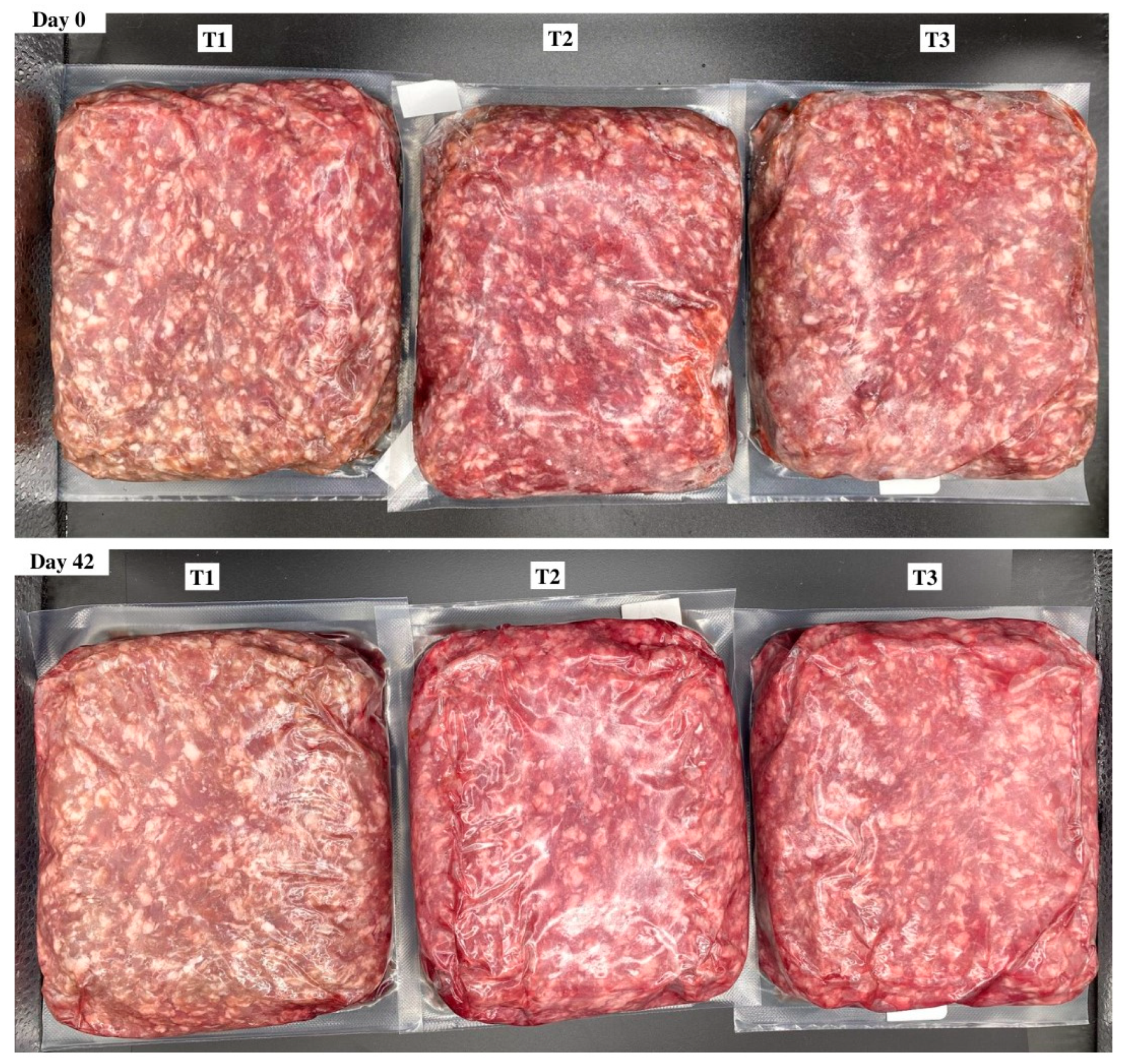
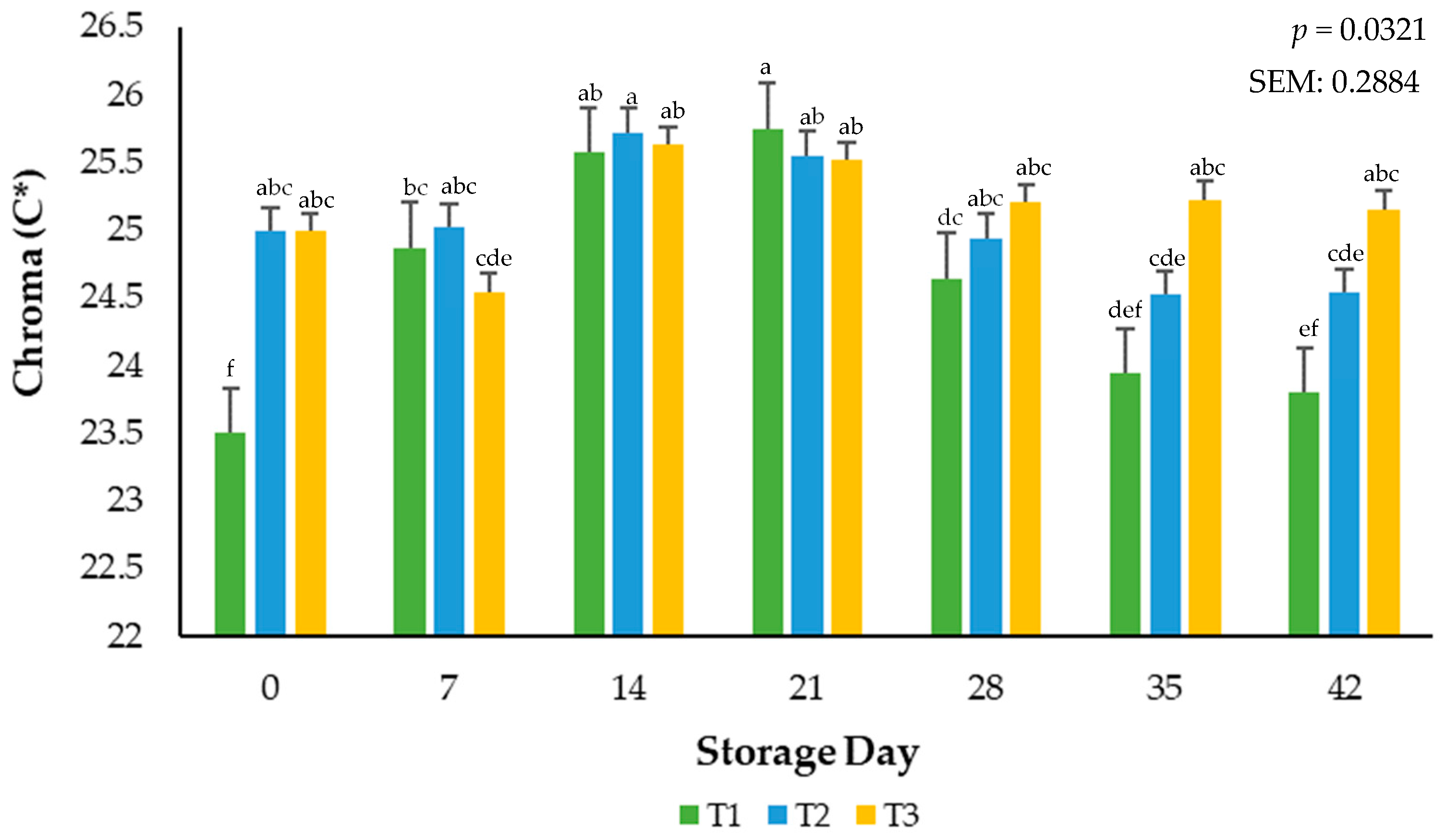
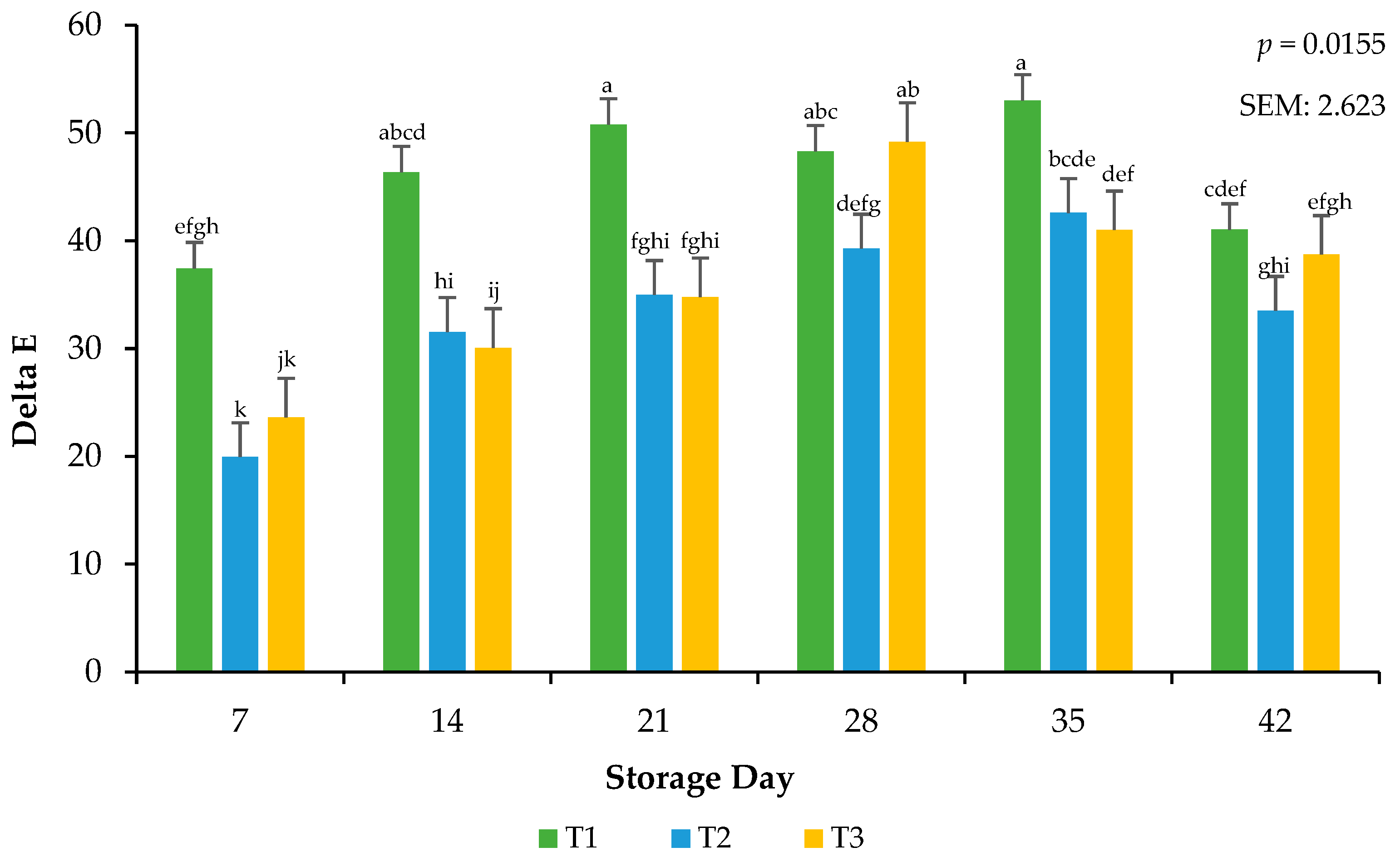
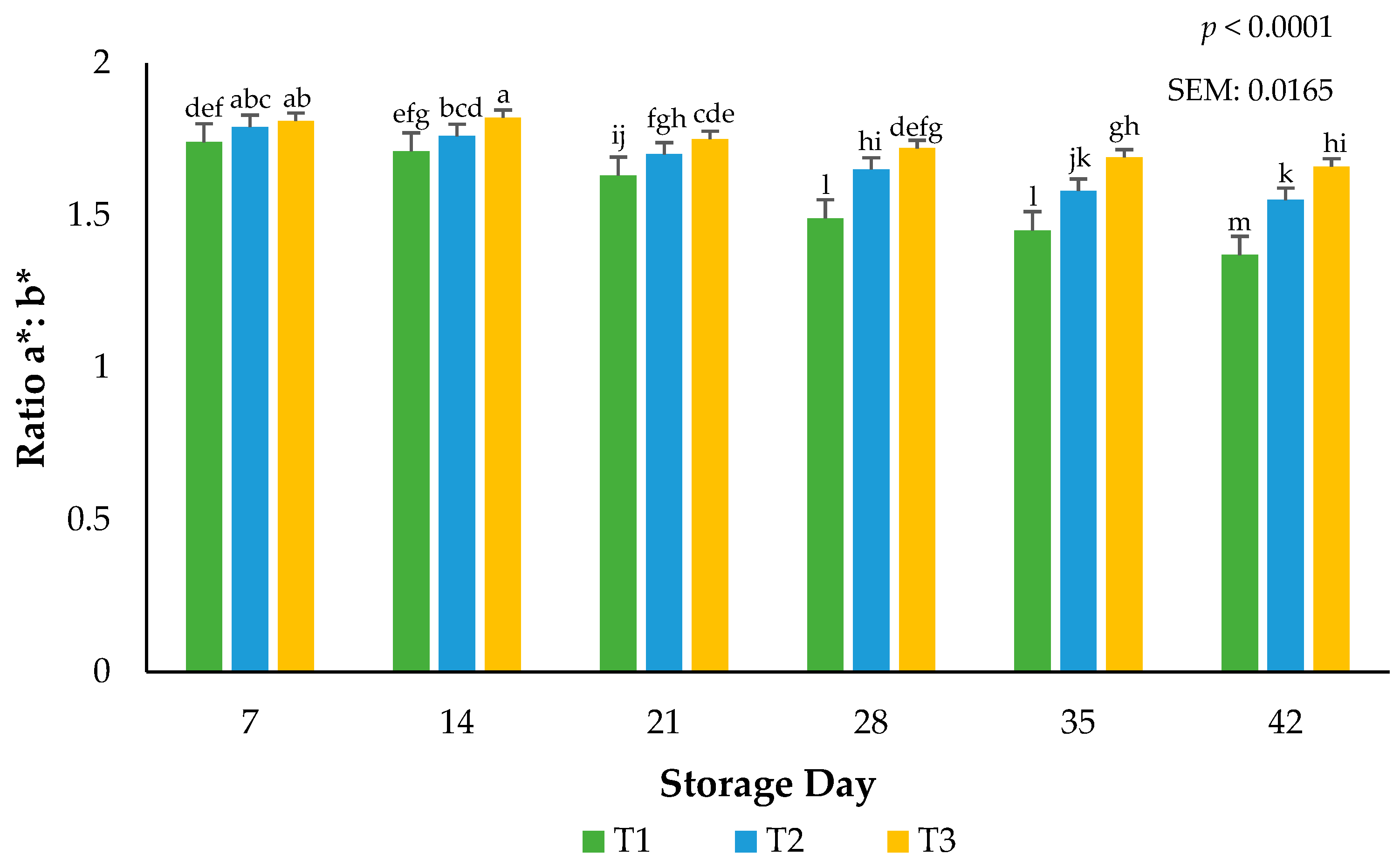
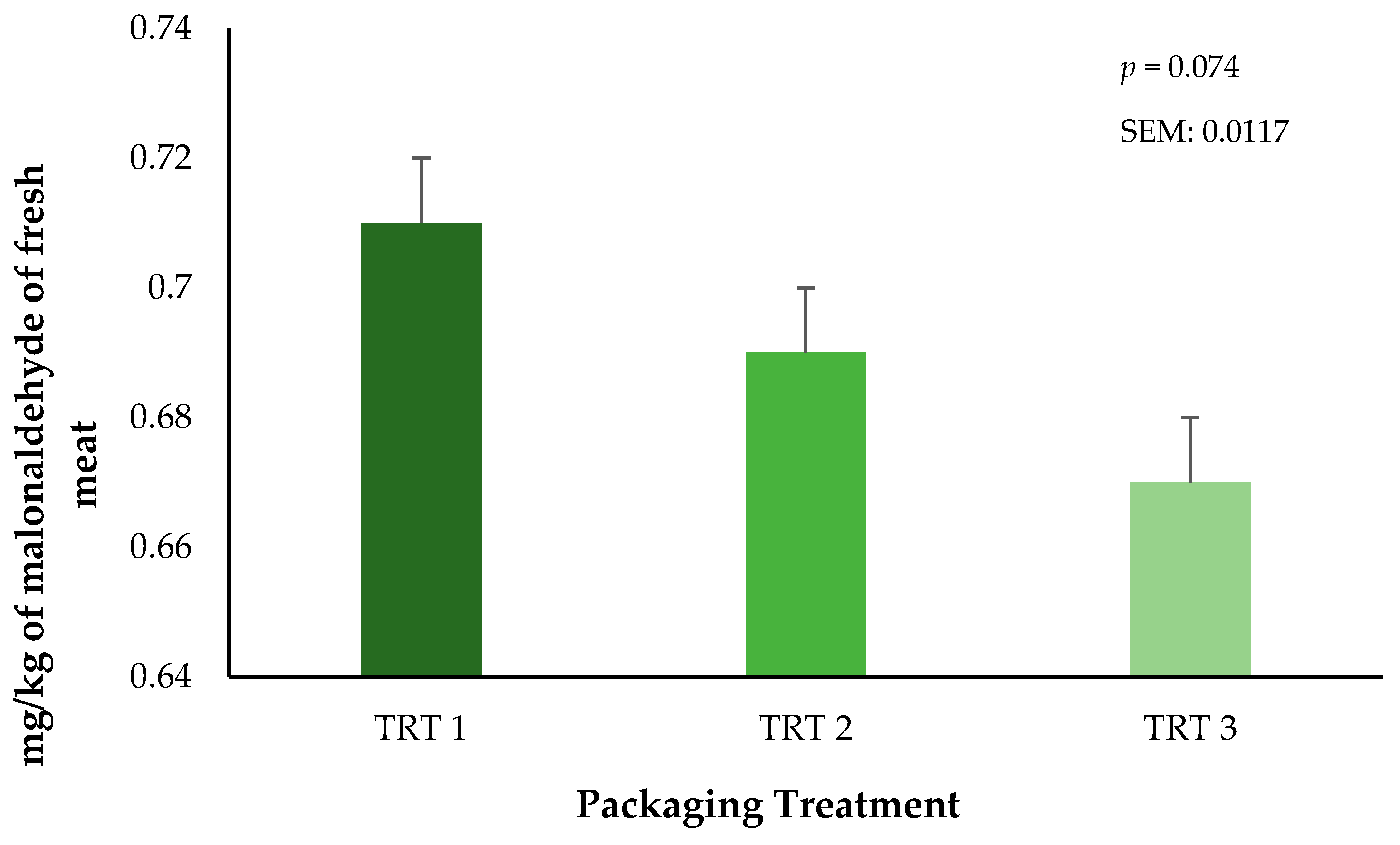
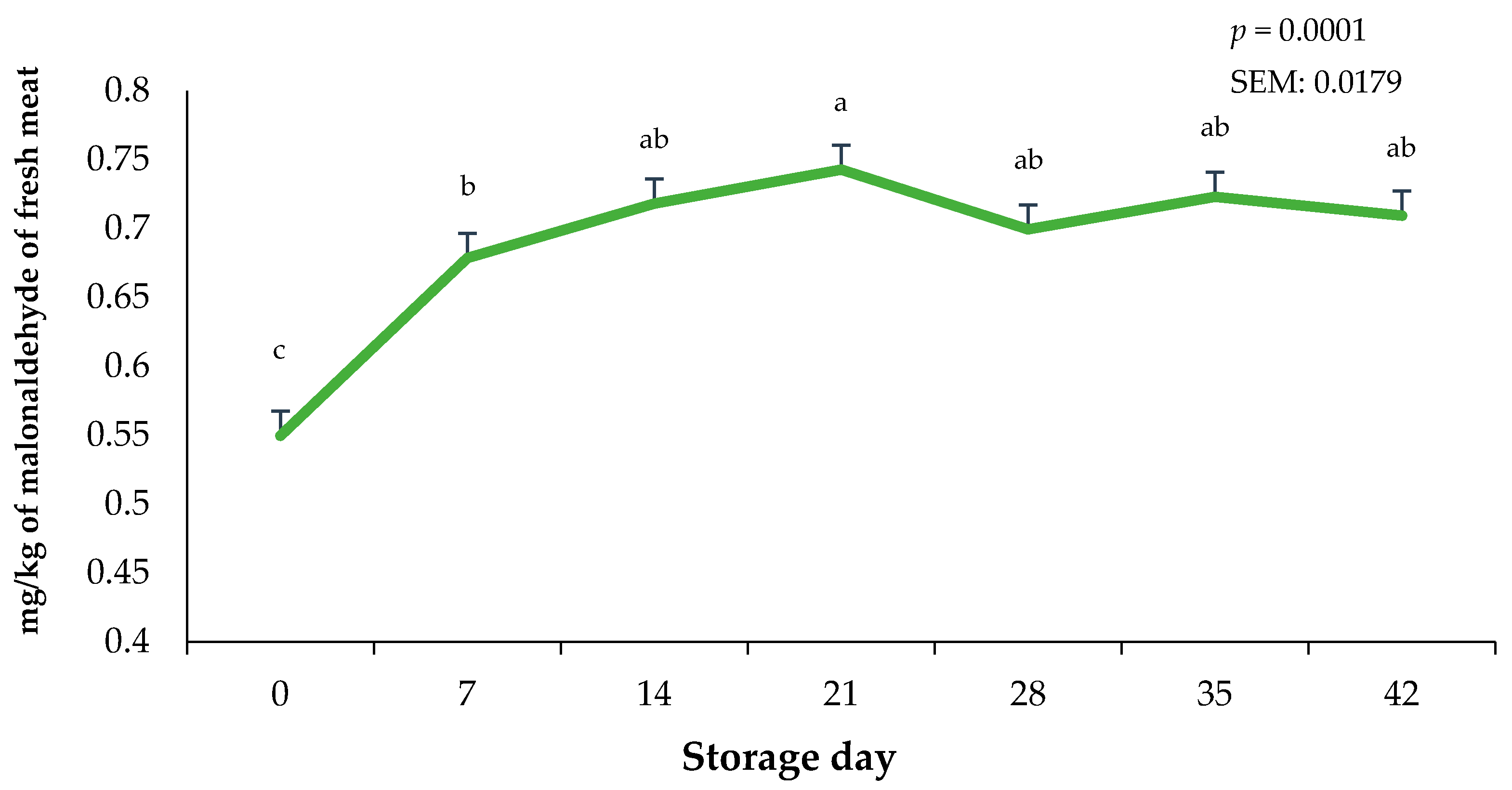
| Treatment | Components 1 | OTR 2 | VPR 3 |
|---|---|---|---|
| T1 | 150 µ polyethylene/EVOH/polyethylene coextrusion | 0.6 cc/sq. m/24 h | 3.2 g/sq. m/24 h |
| T2 | 175 µ polyethylene /EVOH/ polyethylene coextrusion | 0.5 cc/sq. m/24 h | 2.8 g/sq. m/24 h |
| T3 | 200 µ polyethylene /EVOH/ /polyethylene coextrusion | 0.4 cc/sq. m/24 h | 2.4 g/sq. m/24 h |
| Packaging Treatments 1 | |||
|---|---|---|---|
| T1 | T2 | T3 | |
| pH | 5.84 | 5.80 | 5.79 |
| Protein (%) | 22.86 | 22.62 | 22.47 |
| Fat (%) | 15.20 | 15.22 | 15.62 |
| Moisture (%) | 68.62 | 68.49 | 68.16 |
| Surface Color Parameters 1 | |||
|---|---|---|---|
| Lightness (L*) | Redness (a*) | Yellowness (b*) | |
| Packaging Treatment 2 | |||
| T1 | 47.87 a | 20.46 b | 13.51 a |
| T2 | 47.24 b | 21.44 a | 12.90 b |
| T3 | 47.70 a | 21.76 a | 12.65 b |
| Storage Day 3 | |||
| 0 | 40.92 Z | 20.29 Y | 13.49 V |
| 7 | 46.88 Y | 21.62 VW | 12.17 Y |
| 14 | 48.22 X | 22.29 V | 12.66 X |
| 21 | 48.91 W | 22.02 V | 13.06 WX |
| 28 | 49.70 V | 21.19 WX | 13.10 VW |
| 35 | 49.74 V | 20.69 XY | 13.20 VW |
| 42 | 48.84 WX | 20.44 XY | 13.45 VW |
| p-value (Day) * | <0.0001 | <0.0001 | <0.0001 |
| p-value (Treatment) ** | 0.0116 | <0.0001 | <0.0001 |
| p-value (Day × Treatment) *** | 0.5925 | 0.0919 | 0.8965 |
| SEM (Day) * | 0.223 | 0.284 | 0.150 |
| SEM (Treatment) ** | 0.146 | 0.186 | 0.098 |
| Calculated Relative Spectral Parameters 1 | ||
|---|---|---|
| Hue Angle (°) | Red-to-Brown (RTB) | |
| Packaging Treatment 2 | ||
| T1 | 33.61 a | 2.59 b |
| T2 | 31.07 b | 2.83 a |
| T3 | 30.19 b | 2.91 a |
| Storage Day 3 | ||
| 0 | 33.90 W | 2.80 Y |
| 7 | 29.38 Z | 3.13 W |
| 14 | 29.61 Z | 3.01 WX |
| 21 | 30.67 YZ | 2.88 XY |
| 28 | 31.75 XY | 2.59 Z |
| 35 | 32.6 WX | 2.52 Z |
| 42 | 33.90 W | 2.49 Z |
| p-value (Day) * | <0.0001 | <0.0001 |
| p-value (Treatment) ** | <0.0001 | <0.0001 |
| p-value (Day × Treatment) *** | 0.3306 | 0.4393 |
| SEM (Day) * | 0.658 | 0.069 |
| SEM (Treatment) ** | 0.431 | 0.045 |
| Relative Myoglobin Forms 1 | |||
|---|---|---|---|
| Metmyoglobin (MMb) | Deoxymyoglobin (DMb) | Oxymyoglobin (OMb) | |
| Packaging Treatment 2 | |||
| T1 | 24.49 a | 29.06 c | 46.45 b |
| T2 | 21.22 b | 31.25 b | 47.52 a |
| T3 | 20.00 b | 32.72 a | 47.28 ab |
| Storage Day 3 | |||
| 0 | 29.65 U | 22.51 Z | 47.84 V |
| 7 | 16.30 W | 33.26 VW | 50.44 U |
| 14 | 17.85 W | 35.14 U | 47.02 V |
| 21 | 18.68 W | 34.15 UV | 47.18 V |
| 28 | 23.00 V | 31.81 WX | 45.20 W |
| 35 | 23.97 V | 30.63 XY | 45.40 W |
| 42 | 23.90 V | 29.58 Y | 46.53 VW |
| p-value (Day) * | <0.0001 | <0.0001 | <0.0001 |
| p-value (Treatment) ** | <0.0001 | <0.0001 | 0.0460 |
| p-value (Day × Treatment) *** | 0.2810 | 0.2284 | 0.1033 |
| SEM (Day) * | 1.036 | 0.617 | 0.470 |
| SEM (Treatment) ** | 0.678 | 0.404 | 0.308 |
Disclaimer/Publisher’s Note: The statements, opinions and data contained in all publications are solely those of the individual author(s) and contributor(s) and not of MDPI and/or the editor(s). MDPI and/or the editor(s) disclaim responsibility for any injury to people or property resulting from any ideas, methods, instructions or products referred to in the content. |
© 2024 by the authors. Licensee MDPI, Basel, Switzerland. This article is an open access article distributed under the terms and conditions of the Creative Commons Attribution (CC BY) license (https://creativecommons.org/licenses/by/4.0/).
Share and Cite
Bernardez-Morales, G.M.; Douglas, S.L.; Nichols, B.W.; Barrazueta-Cordero, R.J.; Belk, A.D.; Brandebourg, T.D.; Reyes, T.M.; Sawyer, J.T. Vacuum Packaging Can Protect Ground Beef Color and Oxidation during Cold Storage. Foods 2024, 13, 2841. https://doi.org/10.3390/foods13172841
Bernardez-Morales GM, Douglas SL, Nichols BW, Barrazueta-Cordero RJ, Belk AD, Brandebourg TD, Reyes TM, Sawyer JT. Vacuum Packaging Can Protect Ground Beef Color and Oxidation during Cold Storage. Foods. 2024; 13(17):2841. https://doi.org/10.3390/foods13172841
Chicago/Turabian StyleBernardez-Morales, Gabriela M., Savannah L. Douglas, Brooks W. Nichols, Ricardo J. Barrazueta-Cordero, Aeriel D. Belk, Terry D. Brandebourg, Tristan M. Reyes, and Jason T. Sawyer. 2024. "Vacuum Packaging Can Protect Ground Beef Color and Oxidation during Cold Storage" Foods 13, no. 17: 2841. https://doi.org/10.3390/foods13172841
APA StyleBernardez-Morales, G. M., Douglas, S. L., Nichols, B. W., Barrazueta-Cordero, R. J., Belk, A. D., Brandebourg, T. D., Reyes, T. M., & Sawyer, J. T. (2024). Vacuum Packaging Can Protect Ground Beef Color and Oxidation during Cold Storage. Foods, 13(17), 2841. https://doi.org/10.3390/foods13172841







